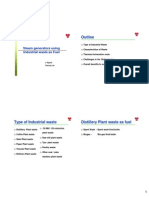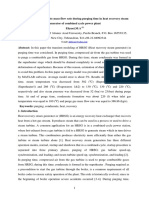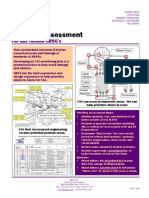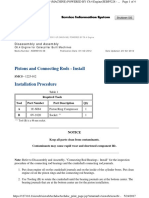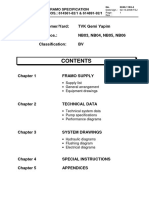0 ratings0% found this document useful (0 votes)
186 viewsAlstom CFB
Alstom CFB
Uploaded by
Coalhouse Walker JuniorThis document summarizes Alstom's circulating fluidized bed (CFB) technology for steam generation. CFB technology allows the combustion of a variety of fuels at lower temperatures, resulting in very low NOx and SO2 emissions without additional equipment. Alstom has three main CFB product types - single grate, cross pass, and dual grate arrangements - suitable for plant capacities from 50MW to over 400MW. Key design aspects include cyclone sizing and maintaining high bed density for effective heat transfer, desulfurization, and combustion.
Copyright:
© All Rights Reserved
Available Formats
Download as PDF, TXT or read online from Scribd
Alstom CFB
Alstom CFB
Uploaded by
Coalhouse Walker Junior0 ratings0% found this document useful (0 votes)
186 views7 pagesThis document summarizes Alstom's circulating fluidized bed (CFB) technology for steam generation. CFB technology allows the combustion of a variety of fuels at lower temperatures, resulting in very low NOx and SO2 emissions without additional equipment. Alstom has three main CFB product types - single grate, cross pass, and dual grate arrangements - suitable for plant capacities from 50MW to over 400MW. Key design aspects include cyclone sizing and maintaining high bed density for effective heat transfer, desulfurization, and combustion.
Original Description:
alstom, circulating fluidized bed
Original Title
alstom cfb
Copyright
© © All Rights Reserved
Available Formats
PDF, TXT or read online from Scribd
Share this document
Did you find this document useful?
Is this content inappropriate?
This document summarizes Alstom's circulating fluidized bed (CFB) technology for steam generation. CFB technology allows the combustion of a variety of fuels at lower temperatures, resulting in very low NOx and SO2 emissions without additional equipment. Alstom has three main CFB product types - single grate, cross pass, and dual grate arrangements - suitable for plant capacities from 50MW to over 400MW. Key design aspects include cyclone sizing and maintaining high bed density for effective heat transfer, desulfurization, and combustion.
Copyright:
© All Rights Reserved
Available Formats
Download as PDF, TXT or read online from Scribd
Download as pdf or txt
0 ratings0% found this document useful (0 votes)
186 views7 pagesAlstom CFB
Alstom CFB
Uploaded by
Coalhouse Walker JuniorThis document summarizes Alstom's circulating fluidized bed (CFB) technology for steam generation. CFB technology allows the combustion of a variety of fuels at lower temperatures, resulting in very low NOx and SO2 emissions without additional equipment. Alstom has three main CFB product types - single grate, cross pass, and dual grate arrangements - suitable for plant capacities from 50MW to over 400MW. Key design aspects include cyclone sizing and maintaining high bed density for effective heat transfer, desulfurization, and combustion.
Copyright:
© All Rights Reserved
Available Formats
Download as PDF, TXT or read online from Scribd
Download as pdf or txt
You are on page 1of 7
ALSTOMS CFB TECHNOLOGY
G.-N. Stamatelopoulos, S. Darling
ALSTOM Power
INTRODUCTION
Steam generators with circulating fluidised bed combustion (CFB) have been utilized throughout the world
over the last few years, in particular for the power generation, but also as industrial power plant and
combined heat and power station. The reason for their success was on the one hand that they could meet the
considerably stricter anti-pollution legislation even without additional add-on equipment, and on the other
hand that fluidised bed combustion plants allow the use of a broad fuel range, which meanwhile also
comprises various sludges and production residues besides different types of coal and biomasses.
Today, more than 900 CFB steam generators are in operation or under construction for the capacity range
from 50 up to over 400 MW
el
. Parallel to the capacity increase of CFB steam generator size the efficiency
and the availability of conventional pulverised coal (PC) fired steam generators was further increased.
Whereas the improvement of the efficiency of PC technology is mainly associated with the increase of the
steam parameters, the availability was improved on account of the operating experience gathered from once-
through steam generators according to the sliding pressure principle. CFB technology may directly benefit
from these developments both in view of the application of materials for steam parameters of up to 270 bar
and 600/620 C for the superheater and reheater outlet and for the design of a CFB steam generator
according to the once-through technology.
With CFB plants the nowadays usually demanded limit values for NO
X
and SO
2
are obtained without any
complex supplementary equipment because of the low combustion temperature of approx. 850 C with
staged air supply, intensive mixing inside the furnace and the addition of additives to the furnace. The
desulphurisation takes place by the natural retention of SO
2
in the lime contained in the fuel ash and through
the injection of dried and treated limestone into the furnace. The particle size of the limestone, the controlled
furnace temperature as well as the high cyclone removal efficiency are the most important factors ensuring
an efficient desulphurisation in the furnace. Thus, usually up to 95 % of the SO
2
produced in the combustion
process can be retained within moderate quantities of added limestone.
The dimensioning and the geometry of the cyclone and the associated inlet duct are decisive factors in order
to maintain the bed density in the furnace and the circulation of the small, lime-rich particles. A high bed
density leads to a more intensified heat exchange and a homogeneous temperature distribution inside the
furnace and enables the fuel particles to remain sufficiently long in the high temperature range.
The greatest challenge for the increase of capacity to 400 up to 600 MW
el
is to apply the excellent operating
experience gained from the CFB plants of capacity class 250 to 350 MW
el
to the larger plants and to
accompany this capacity increase with the introduction of the supercritical technology. In the next sections
Alstoms product portfolio and specific design features are presented and the required steps of design for a
supercritical plant in the upper capacity range are discussed.
ALSTOMS PRODUCT PORTFOLIO
There are three main CFB product types within Alstoms portfolio. The application of each product type
depends mainly on the capacity of the plant, but also on fuel, or operational requirements.
Single grate, in line arrangement
Figure 1 gives an overview of the arrangement. The CFB boiler comprises a single grate combustion
chamber, which is fed from both front and rear walls with fuel, limestone and combustion air. The three
major parts of the boiler combustion chamber, cyclone and second pass - are arranged in line. The
combustion of the fuel and the primary desulphurisation of the flue gas takes place in the combustion
chamber. In the lower part of the combustion chamber the bed is most dense, with its density decreasing with
increasing height. Secondary air staging in order to keep the NO
X
emissions at low levels is typically applied.
Flue gas carrying solids enters the cyclone, where the solids are separated and recirculated back to the
furnace, while the flue gas enters the second pass, where the convective heating surfaces are arranged. The
convective heating surfaces are followed by the air preheater. In Figure 1 a regenerative air preheater is
shown; tubular air preheaters can also be applied. In the primary solids recirculation of the CFB boiler both
internal within the furnace and external heat exchangers like fluidised bed heat exchangers (FBHE)
can be included. In this arrangement the basic width of one combustion chamber cell can be multiplied in
order to accommodate the arrangement of additional cyclones. This arrangement is suitable for capacities up
to 350 MW
el
and Alstom has applied this arrangement with up to three cyclones.
+55.4 m
+ 2.3 m
Figure 1: Single grate, in line arrangement
Cross pass arrangement
Figure 2 gives an overview of the arrangement. This arrangement represents a variant of the single grate, in
line arrangement. The main distinguishing feature is the installation of part of the convective heating
surfaces in a cross pass arranged on the top of the combustion chamber and after the cyclone. This allows a
more compact design, while keeping all the features described above for the single grate, in line
arrangement. This arrangement is suitable for capacities up to 150 MW
el
.
+53.0 m
0.0 m
Figure 2: Cross pass arrangement
Figure 4: Cyclone example
Dual grate (pantleg) arrangement
Figure 3 gives an overview of this arrangement, which is applied for capacities higher than 300 MW
el
. It
comprises an even number of cyclones typically four, or six that are arranged on the furnace side walls.
Compared with the arrangements in Figure 1 and 2 above not only the width, but also the length of one
combustion chamber cell increases. In order to account for this and ensure a good mixing of the fuel,
limestone and combustion air entering the lower part of the furnace, the latter is designed as a dual grate,
allowing secondary air inlets at both sides of each leg. The flue gas leaving the cyclones is led through a
common duct into the second pass, which is located behind the rear wall of the furnace.
Figure 3: Dual grate (pantleg) arrangement
CFB DESIGN PRINCIPLES
CFB references for the utilization of a big variety of fuels exist today.
Coal and lignites with water content up to 60 %, ash content up to
40 % and sulphur up to 14 % (daf) have been utilized successfully.
References exist also for the utilization of slurry, sewage sludge,
petroleum coke and bark. Besides the ability to burn a wide range of
fuels including difficult to burn fuels and opportunity fuels, CFBs
have achieved impressive environmental performance, especially low
NO
X
emissions and economic in-furnace desulfurization by limestone
addition.
The cyclone sizing and geometry, which includes the design of the
inlet duct, is at the heart of Alstom CFB combustion technology: the
capture efficiency of the separation system is the decisive factor in
maintaining the bed density and retaining the fine calcium rich
particles in the primary loop. A high bed density in turn ensures a
high heat transfer and a uniform temperature in the furnace, a high
contact between lime particles and SO
2
rich flue gas for optimum
sulphur capture efficiency and of course the best possible combustion
by keeping the fuel particles in the furnace for the longest possible
time. It also has a beneficial impact on NO
X
emissions, due to the
creation of isothermal conditions at the inlet of the primary loop. A
lot of development effort is expended annually in order to
continuously improve the cyclones separation efficiency and
optimise its operational performance. Figure 4 gives an overview of
the main feature of the Alstom cyclone. Such cyclones can be either
refractory lined, or tubed and steam-cooled. The latter is advantageous, when targeting at supercritical
conditions.
While post-combustion control equipment can be used with CFB technology to meet special emissions
requirements, the very low NO
X
emissions that CFB combustion achieves without any secondary measures
can be attributed to the following reasons:
relatively low and uniform furnace temperature of approx. 850 C to 900 C;
air staging in the lower furnace by primary air and secondary air introduction at appropriate levels,
resulting in substoichiometric combustion conditions in the lower furnace hopper;
equal distribution of fuel and air by the intense mixing inside the furnace;
positive impact of high efficiency cyclones that result in isothermal conditions in the primary loop.
NO
X
emissions can be further reduced via Selective Non-Catalytic Reduction (SNCR) wherein an ammonia-
based reagent is injected into the flue gas at the appropriate location(s). The ammonia converts NO
X
to
elemental nitrogen and water. Such systems have achieved NO
X
reductions of over 50 %. Alstom has
experience with all types of SNCR reagents; anhydrous ammonia, aqueous ammonia and urea.
Sulphur capture is achieved through inherent capture by the fuel bound lime and injection of prepared and
dried limestone in the furnace. The crushed limestone is pneumatically fed into the CFB through adequate
injection points. The particles size distribution (PSD) is an important factor in the sulphur capture process
efficiency, together with carefully controlled temperature and high cyclone efficiency. When equipped with
high efficiency cyclones, CFB boilers are typically able to capture up to 95 % of the SO
2
generated by the
combustion of the fuel at moderate limestone addition rates.
To simplify the process of preparing limestone for injection, Alstom developed and patented the Just-In-
Time (JIT) limestone feed system. This system consists of a day silo containing raw limestone, a feeder, an
air-wept crusher/dryer and piping to convey the sized and dried limestone directly to the furnace. Heat for
drying is provided by hot air from the air preheater. The JIT systems is shown schematically in Figure 5.
ROLLER
MILL
LIMESTONE
SILO
GRAVIMETRIC FEEDER
SLIDE GATE
HOT PA
AIR
TEMPERING
AIR
R
A
W
L
I
M
E
S
T
O
N
E
FURNACE ISOLATION
VALVE
TO FUEL FEED
Figure 5: JIT System
The heart of the JIT systems is the roller mill, which is an Alstom-supplied roller mill. Alstom has
experience with the JIT system incorporating roller mills of CFBs up to 300 MW
el
capacity.
TC
ESP or bag filter
Ash Recirculation
Mixer
Water
Sorbent End product
Figure 6: NID Process Diagram
In order to achieve lower SO
2
values for high sulphur fuels, the NID process [1] shown in Figure 6 (also
known as FDA in the US) can be applied, which is based on the absorption of SO
2
by the available lime in
the flyash. The key parameter to be controlled in any dry FGD process is the humidity of the flue gas in the
reaction zone, i. e. the reactor and the subsequent dust collector. At a relative humidity of 40 50 %; the
lime is activated and readily absorbs SO
2
. Water is added by moistening the ash, which is being recirculated
from a dust collector. The water is distributed onto the surface of dust particles in a mixer, resulting in a
water content of only a few percent. The recycle ash behaves like a dry powder and is still free flowing.
Due to the high surface area available for the water, the added water flashes off immediately, once the
moistened dust is brought into contact with the flue gas. This in turn results in a very small reactor size.
A unique feature of the NID technology is the fact that all recycled absorbent is subject to wetting in the
mixer which maximizes the utilization of the recycled absorbent. After the activation/drying step, the dried
recycle dust is separated from the flue gas in a highly efficient dust collector.
For a better utilisation of the heat release in the primary loop and for a more economic arrangement the CFB
process offers the possibility to install additional heating surfaces in the primary loop, either as in furnace
surfaces, or as external fluidised bed heat exchangers. Figure 7 shows an example of an in-furnace heating
surface arranged as an omega panel and bringing the finishing superheat duty and Figure 8 shows an
example of in-furnace surface arranged as a wingwall. On the other hand, when utilising more than two
external heat exchangers additional possibility to control the furnace temperature is given, as well to control
without reheat spray the finishing reheater temperature.
Figure 7: Omega Panels
Figure 8: Wingwall
FURTHER SCALE-UP AND SUPERCRITICAL DESIGN
Whereas most of the CFB plants in operation are designed as natural circulation or forced circulation plants,
there is a great number of PC firing plants which are designed as once-through plants. Table 1 shows an
extract from some Alstom references, which are designed for high steam parameters according to the once-
through principle. The experience gained from the design and operation of these plants can be completely
transferred to the CFB plants.
Table 1 Pulverised fuel firing plants according to the once-through principle
Plant Start-up Fuel Capacity
[MW]
Steam mass
flow
[t/h]
Design
pressure
[bar]
Temperature
SH/RH steam
[C]
Bechatw 2008 Lignite 833 2,424 284 554/582
Neurath F/G 2008 Lignite 1,122 2,959 295 600/605
Ptnw 2004 Lignite 460 1,345 290 544/568
Wai Gao Qiao, II 2003
Bituminous
coal
2 x 900
(980)
2,789 279 542/568
Yonghung 2003
Bituminous
coal
2 x 800 2,415 271 569/569
Niederaussem K 2002 Lignite 1,012 2,662 290 580/600
Florina 2002 Lignite 330 1,017 262 543/542
Mai Liao 2000
Bituminous
coal
2 x 600 1,950 279 540/569
Schwarze Pumpe 1997 Lignite 2 x 800 2,420 285 547/565
Poryong 3 & 4 1993
Bituminous
coal
2 x 500 1,720 265 541/541
Vestkraft, Unit 3 1992
Bituminous
coal
400 1,080 276 560/560
Shidongkou II 1992
Bituminous
coal
2 x 600 1,897 268 541/569
GKM Mannheim, 18 1982
Bituminous
coal
475 1,370 275 530/540/530
Scholven, Unit F 1979
Bituminous
coal
4 x 750 2,200 230 535/535
The two most important considerations for the design of the evaporator of a once-through steam generator
are:
a sufficient cooling of the evaporator tubes in any operating condition and
the reduction of the temperature differences between the evaporator tubes to a minimum.
The temperature differences at the evaporator outlet are the result of a non-uniform heat absorption of the
evaporator tubes and the differences in length and pressure loss. Whereas the water mass flow in natural
circulation steam generators is slightly increased in case of a load reduction, the mass flow with once-
through steam generators is linearly dependent on the load. Therefore, a detailed analysis is to be performed
in such systems for cooling the evaporator tubes over the entire load range as well as for the determination of
the minimum once-through load. Then, the tube dimensions are to be selected accordingly. Tube diameters
from 51 mm to 63.5 mm just as for natural circulation boilers do not lead to suitable mass flow densities for
once-through systems.
Whereas the mass flow density required for cooling is ensured for PC plants by means of the spiral-tubed
evaporator wall, this alternative cannot be adapted for CFB plants owing to potential problems of erosion of
the enclosing walls. The enclosing wall is vertically tubed. A possibility of avoiding high metal temperatures
is the installation of internally finned tubes instead of plain tubes. In principle, the dryout point is shifted
towards higher steam contents due to the interior finning, thus improving the cooling of the tubes in the area
of the high heat flux densities. Detailed heat transfer calculations have shown, however, that the interior
finning hardly involves any advantages for CFB plants. As the highest heat flow density for fluidised bed
combustion plants is lower than for PC plants and occurs inside the furnace at low levels, hardly any
differences in cooling can be discovered between internally finned tubes and plain tubes.
In addition, the heat transfer to the enclosing walls of CFB plants is not influenced by slagging and fouling.
The evaporator walls remain clean, on the one hand owing to the low furnace temperatures lower than the
ash softening point and due to the cleaning effect of an ash layer moving downwards along the wall. This
leads to a more homogeneous heat absorption of the evaporator walls in comparison with PC plants.
Therefore, a lower mass flow density of the evaporator walls is also sufficient for cooling.
The height of the furnace is only insignificantly increased with the capacity of the plant. It may occur in the
upper capacity range that the enclosing walls alone cannot offer a sufficient evaporator heating surface. The
necessary additional heating surface can be arranged either parallel to the enclosing wall in the furnace or in
series in a fluidised bed heat exchanger. In the latter case, attention should be paid to the distribution of the
water/steam mixture. [2]
SUMMARY
The fluidised bed technology can contribute towards an efficient, environmentally compatible and economic
electrification using coal and other fuels. Alstoms recent projects have demonstrated important benefits of
the CFB technology. These benefits include:
Achieving over 95 % availability during commercial operation
Achieving 95 % desulphurisation with in-furnace desulphurisation only or > 98 % desulphurisation with
combination of in-furnace desulphurisation and secondary measures
No addition of sorbents for secondary measures in case of NID process
A significant contribution to the good desulphurisation is the high efficiency of the cyclone separators.
Alstom has continuously optimised separator design and improved the limestone utilization. A second
milestone is the combination with the NID process with allows to achieve highest desulphurisation rates with
limestone quantities which are close to the limestone consumption of wet FGD plants.
The success of the CFB technology in countries with a high share of coal in the electricity generation
underlines the high market potential of CFB plants. In recent years, the fluidised bed plant has become
established in the capacity range from 250 to 350 MW
el
. A further capacity increase up to 600 MW
el
is
possible and remains to be realized. The introduction of supercritical parameters even further improves the
economic efficiency and additionally allows the reduction of CO
2
emissions. In this connection, the fluidised
bed technology takes advantage of the design and operating experience of PC plants. Particularly in the area
of the materials and once-through technology the experience from PC plants can be directly applied to the
fluidised bed.
REFERENCES
[1] Gabriel, C.; Seeber, J.; Ahman, S.; Seluk, N.: Operational Experience with High Sulphur Fuels in
Combination with CFB and Secondary Desulphurisation Measures. VGB CFB Workshop, September
2004, Germany
[2] Stamatelopoulos, G.-N.; Seeber, J.; Semedard, J.-C.; Skowyra, R. S.: Advancement in CFB Technology:
A Combination of Excellent Environmental Performance and High Efficiency. Power-Gen Europe
2004, 25. - 27. May 2004, Barcelona, Spain
You might also like
- Ecu (Electronic Control Unit) (E28, E32) : 1) 2002 MODELDocument12 pagesEcu (Electronic Control Unit) (E28, E32) : 1) 2002 MODEL08088338100% (2)
- Alstom BoilerDocument15 pagesAlstom BoilertuyencntnNo ratings yet
- Cold Light Up Operational ChecklistDocument10 pagesCold Light Up Operational ChecklistIEPL BELANo ratings yet
- B&W IR-CFB: Operating Experience and New Development: Technical PaperDocument8 pagesB&W IR-CFB: Operating Experience and New Development: Technical PaperS. P.No ratings yet
- VEGA - Indonesia PresentationDocument62 pagesVEGA - Indonesia PresentationSteve WanNo ratings yet
- Smart Soot Blower SystemDocument8 pagesSmart Soot Blower SystemidigitiNo ratings yet
- Reciprocating Compresor TrainingDocument57 pagesReciprocating Compresor TrainingManuel Quimson100% (11)
- SOLENOIDS Publication PDFDocument3 pagesSOLENOIDS Publication PDFalcoholahmed100% (1)
- Babcock and Wilcox Boiler.Document9 pagesBabcock and Wilcox Boiler.Sajid RazaNo ratings yet
- B&W FBC Boiler Opeating Experience With U BeamsDocument9 pagesB&W FBC Boiler Opeating Experience With U BeamsNath BoyapatiNo ratings yet
- Operation of 300MW CFBC BoilerDocument6 pagesOperation of 300MW CFBC BoilerSoodamany Ponnu PandianNo ratings yet
- 3 Benefites of CFB Boiler Over Pc-Fired BoilerDocument9 pages3 Benefites of CFB Boiler Over Pc-Fired BoilersunitbhaumikNo ratings yet
- Nozzles Inc FB RevDocument9 pagesNozzles Inc FB Revalianndsa arshadNo ratings yet
- Coal Flow Ability Report - Bunker Coal Flow Study For Anpara-DDocument35 pagesCoal Flow Ability Report - Bunker Coal Flow Study For Anpara-DParikshit MukherjeeNo ratings yet
- GEECO Enercon Pvt. Limited: Raph - Esp - CFD - Fea - Fes - Testing - TrainingDocument24 pagesGEECO Enercon Pvt. Limited: Raph - Esp - CFD - Fea - Fes - Testing - TrainingAkasthiyanNo ratings yet
- CFB Refractory Repair: Power January 2006Document10 pagesCFB Refractory Repair: Power January 2006num0067No ratings yet
- Boiler and AuxiliariesDocument29 pagesBoiler and Auxiliariesnsarav100% (1)
- FBC Boilers: Syllabus FBC Boilers: Introduction, Mechanism of Fluidized Bed Combustion, AdvantagesDocument12 pagesFBC Boilers: Syllabus FBC Boilers: Introduction, Mechanism of Fluidized Bed Combustion, AdvantagesTejas T S TejasNo ratings yet
- Biomass (Rice Straw) Fired BoilerDocument9 pagesBiomass (Rice Straw) Fired BoilerSnehashis MaityNo ratings yet
- Supercritical Benson BoilerDocument18 pagesSupercritical Benson BoilerJerry Mateo100% (2)
- Design and Operating Features of New 27.6 Mva Furnace at Nava Bharat Ventures Limited, PalonchaDocument4 pagesDesign and Operating Features of New 27.6 Mva Furnace at Nava Bharat Ventures Limited, PalonchaKvvPrasadNo ratings yet
- Boilers For Plant Waste-RajavelDocument21 pagesBoilers For Plant Waste-RajavelSathish PaulNo ratings yet
- CFB Boiler Cethar NewFeb09Document21 pagesCFB Boiler Cethar NewFeb09mukthipatiNo ratings yet
- Posiflow Technology of Doosan Babcock For Supercritical BoilersDocument12 pagesPosiflow Technology of Doosan Babcock For Supercritical BoilersKarthick VelayuthamNo ratings yet
- 3s Steam BoilerDocument13 pages3s Steam BoilertahirNo ratings yet
- Economizer Recirculation For Low-Load Stability in Heat Recovery Steam GeneratorDocument10 pagesEconomizer Recirculation For Low-Load Stability in Heat Recovery Steam GeneratorknsaravanaNo ratings yet
- Sub Critical Utility BoilersDocument25 pagesSub Critical Utility BoilersceddievanNo ratings yet
- Foster Wheeler CFB BoilerDocument9 pagesFoster Wheeler CFB BoilerNustanto NustantoNo ratings yet
- Pulverized CoalDocument11 pagesPulverized CoalAdrian ManzanoNo ratings yet
- Ash ReinjectionDocument22 pagesAsh Reinjectiongaol_bird009No ratings yet
- Alstom - BoA 2&3 + WTA - 2008Document8 pagesAlstom - BoA 2&3 + WTA - 2008fransdaunNo ratings yet
- FBC Operation II OperationDocument21 pagesFBC Operation II Operationanbesivam87No ratings yet
- FGD 001Document30 pagesFGD 001tanmaymajhi09_796764100% (1)
- Boiler: Sabari Girish N Sr. Engineer (O)Document37 pagesBoiler: Sabari Girish N Sr. Engineer (O)Deepak SinghNo ratings yet
- Fluidized Bed CombustionDocument32 pagesFluidized Bed CombustionAbdul AhadNo ratings yet
- Bi-Drum Vs Single Drum - Research Paper 2Document6 pagesBi-Drum Vs Single Drum - Research Paper 2Parth Merchant100% (1)
- Pulverizers PDFDocument6 pagesPulverizers PDFOscar DorantesNo ratings yet
- U4OHREPORT2008Document88 pagesU4OHREPORT2008Anonymous pKsr5vNo ratings yet
- Boiler AnnexDocument66 pagesBoiler Annexrenjithv_4No ratings yet
- CFBC SHORT NOTESDocument8 pagesCFBC SHORT NOTESanbarasanNo ratings yet
- Uninterrupted and Reliable Operation For CFB BOILERDocument59 pagesUninterrupted and Reliable Operation For CFB BOILERRizqi PriatnaNo ratings yet
- TDP - 2019 - Public - Forum - Presentation - 30 - Oct2019 - Final1Document223 pagesTDP - 2019 - Public - Forum - Presentation - 30 - Oct2019 - Final1anon_b186No ratings yet
- NTPC (National Thermal Power Corporation) Sipat Mechanical Vocational Training Report 4-Haxxo24 I IDocument44 pagesNTPC (National Thermal Power Corporation) Sipat Mechanical Vocational Training Report 4-Haxxo24 I Ihaxxo24No ratings yet
- HRSG DeaeratorDocument2 pagesHRSG DeaeratorTripoli2010No ratings yet
- Boiler1 PDFDocument8 pagesBoiler1 PDFkhang10182No ratings yet
- Firing of DolaCharDocument14 pagesFiring of DolaCharS V NAGESHNo ratings yet
- AFBC BoilerDocument12 pagesAFBC BoilerNaman Sharma0% (1)
- Firing Diagram Based On Design Load PDFDocument2 pagesFiring Diagram Based On Design Load PDFxaver lawNo ratings yet
- Co-Firing of Biomass in Coal Fired Utility Boiler-2003-Kati SavolainenDocument13 pagesCo-Firing of Biomass in Coal Fired Utility Boiler-2003-Kati SavolainenantjobNo ratings yet
- Bwe Aph-GghDocument20 pagesBwe Aph-GghDaniellzhangNo ratings yet
- 1.1 Salient Features of CFBC BoilerDocument17 pages1.1 Salient Features of CFBC BoilerJAY PARIKHNo ratings yet
- ME LAB MANUAL RevisedDocument64 pagesME LAB MANUAL RevisedClint Baring ArranchadoNo ratings yet
- Gravimetric Feeder For Pulvurised FuelDocument2 pagesGravimetric Feeder For Pulvurised FuelVijay KumarNo ratings yet
- Stoker Vs FBC PDFDocument11 pagesStoker Vs FBC PDFAsghar MirzaNo ratings yet
- Supercritical Technology in BoilersDocument17 pagesSupercritical Technology in BoilersKARTHIGEYAN.R100% (1)
- ESP BasicsDocument38 pagesESP Basicssen_subhasis_58No ratings yet
- Boiler Furnace PDFDocument8 pagesBoiler Furnace PDFசுந்தர மூர்த்தி சேப்பிளையார்No ratings yet
- CFCB Bed Ash CoolerDocument11 pagesCFCB Bed Ash CoolerUdhayakumar VenkataramanNo ratings yet
- CFBC BoilersDocument11 pagesCFBC BoilersManoj DesaiNo ratings yet
- Alstom BFB PDFDocument18 pagesAlstom BFB PDFNaveed RabbaniNo ratings yet
- Fluidized Bed Combustion (FBC) in Coal Based Thermal Power PlantsDocument10 pagesFluidized Bed Combustion (FBC) in Coal Based Thermal Power PlantsShambhu MehtaNo ratings yet
- CFBC & PFBC TechnologyDocument18 pagesCFBC & PFBC TechnologyomiitgNo ratings yet
- Encyclopaedia Britannica, 11th Edition, Volume 8, Slice 3 "Destructors" to "Diameter"From EverandEncyclopaedia Britannica, 11th Edition, Volume 8, Slice 3 "Destructors" to "Diameter"No ratings yet
- Condensate in HRSG PDFDocument15 pagesCondensate in HRSG PDFCoalhouse Walker JuniorNo ratings yet
- HRSG FAC Risk AssesmentDocument1 pageHRSG FAC Risk Assesmentandersonr3160No ratings yet
- Balance of Plant - Standard Technical SpecificationDocument238 pagesBalance of Plant - Standard Technical SpecificationAmitava Paul100% (2)
- BiomassDocument28 pagesBiomassCoalhouse Walker JuniorNo ratings yet
- Chiller CompressorsDocument41 pagesChiller Compressorsdennrich100% (2)
- Hydraulic Division Product Overview: Innovative Motion Control & Energy Management SolutionsDocument10 pagesHydraulic Division Product Overview: Innovative Motion Control & Energy Management SolutionsCJReyes7No ratings yet
- Project On Submarines and TorpedoesDocument24 pagesProject On Submarines and TorpedoesPrince MultaniNo ratings yet
- CLASSIC 300D Kubota: Parts List ForDocument28 pagesCLASSIC 300D Kubota: Parts List ForJuank RodriguezNo ratings yet
- Wireline Equipment Standard Norsok PDFDocument14 pagesWireline Equipment Standard Norsok PDFPedro Paulo CordeiroNo ratings yet
- Pistons and Connecting Rods - InstallDocument4 pagesPistons and Connecting Rods - InstallPutra Jawa100% (1)
- Ocused: ON UccessDocument56 pagesOcused: ON UccessresuviatorNo ratings yet
- Comparison of Microbial Electrolysis Cells Operated WithDocument7 pagesComparison of Microbial Electrolysis Cells Operated WithCici SafitriNo ratings yet
- CrudeoilDocument35 pagesCrudeoilmohanNo ratings yet
- 0240 1183 4Document12 pages0240 1183 4Marko ŠkaraNo ratings yet
- Chapter 03 - Start, Stop and OperationDocument38 pagesChapter 03 - Start, Stop and OperationnikolasthermosolutionsNo ratings yet
- 4.furnaces: What Is A Furnace?Document36 pages4.furnaces: What Is A Furnace?aravind grandhiNo ratings yet
- Engine D-243, D-245 Operation and Maintenance ManualDocument72 pagesEngine D-243, D-245 Operation and Maintenance Manualaritmetics100% (3)
- Questions & Answers: Hydraulic & Landing GearsDocument14 pagesQuestions & Answers: Hydraulic & Landing GearsRizkinsya IlhamNo ratings yet
- Biodiesel Production From Vegetable OilDocument23 pagesBiodiesel Production From Vegetable Oilnghiemta18100% (1)
- Sulphur 2020: From Contracting To Final CombustionDocument24 pagesSulphur 2020: From Contracting To Final Combustionvran77No ratings yet
- Electrochemical Energy Systems: Batteries and Fuel CellsDocument42 pagesElectrochemical Energy Systems: Batteries and Fuel Cellsshubhika guptaNo ratings yet
- Apag 20190422Document21 pagesApag 20190422Ghasem BashiriNo ratings yet
- Me6412 Thermal Engineering Laboratory Manual - IDocument126 pagesMe6412 Thermal Engineering Laboratory Manual - IBIBIN CHIDAMBARANATHAN100% (4)
- Main Diesel Engine Cooling SystemDocument4 pagesMain Diesel Engine Cooling SystemconcernizationNo ratings yet
- Xas186dd PDFDocument2 pagesXas186dd PDFJoelNo ratings yet
- Grupos Electronicos Diesel Cat n3306 225ekw PrimeDocument4 pagesGrupos Electronicos Diesel Cat n3306 225ekw PrimejalexivanNo ratings yet
- Performance and Emission Analysis of DTS-I EngineDocument23 pagesPerformance and Emission Analysis of DTS-I EnginerahulNo ratings yet
- GTST Protection TestDocument3 pagesGTST Protection Testluriah100% (2)
- 350 DFCC Exhaust Emission Data - Eds-114Document1 page350 DFCC Exhaust Emission Data - Eds-114ZJ Limited (ZJLimited)No ratings yet
- Caterpillar C9 Engine Specs PDFDocument3 pagesCaterpillar C9 Engine Specs PDFTungFengNo ratings yet
- Terra-Marine Short Form CVDocument3 pagesTerra-Marine Short Form CVtashfinNo ratings yet
- Denyo - DCADocument1 pageDenyo - DCAvicky beastNo ratings yet





















